How to Hard Boil an Egg
Make the perfect hard-boiled egg.
by
Doug
Updated April 8, 2011
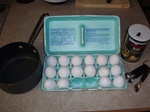
Eggs, salt and saucepan used for hard boiling eggs.
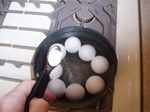
Add teaspoon of salt to water.
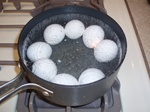
Bring to rapid boil (water should start rolling on the surface).
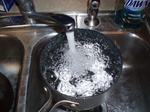
Run cold water over eggs.
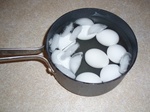
Add ice cubes to water and let stand for 10 minutes.
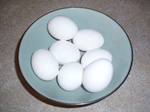
Take eggs out of water to refrigerate or peel and eat.
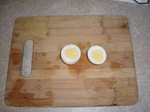
Hard-boiled egg sliced in half.
Timing is everything when making the perfect hard-boiled egg. Follow the directions below to make hard-boiled eggs that are cooked just right!
Directions
- Place eggs in saucepan/ pot (do not stack eggs on top of each other).
- Turn on the faucet and fill saucepan with slightly cool water until the eggs are covered by an inch to an inch-and-a-half of water. Then add a teaspoon of salt to the water.
- Bring water to a rapid boil (water should start rolling around on the surface). Once the rapid boil starts, allow the eggs to boil for exactly 30 seconds (make sure you time it).
- Turn off the burner on the stove and immediately remove pan from the heat and then cover the saucepan tightly with a lid.
- Set your kitchen timer for 15 minutes and let the eggs stand with the cover still on.
- Remove cover, and run cold water over eggs for approximately 1 minute. Leave cold water covering the eggs and then place 6-10 ice cubes in the pan with the eggs.
- Let the eggs cool in the cold water for 10 minutes, then drain and remove eggs. (For firmer yolks, leave the eggs to cool in cold water for as long as two hours.)
- The hard-boiled eggs are now ready to be peeled or stored in your refrigerator for up to 1 week.
Tips
- Keep a close watch on the time... Make sure you use a kitchen timer to boil eggs for exactly 30 seconds, and then let the eggs stand with a cover on top for exactly 15 minutes.
- Try to use eggs that are 5 to 7 days old, this is because older eggs are less likely to crack when boiling and are much easier to peel when compared with fresh eggs.
- Avoid stacking eggs 2 or 3 layers in a pot, because they are more likely to cook unevenly.
- Too much water can cause the cooking time to get thrown off, which could lead to overcooked eggs. Too little water can cause parts of the egg to be undercooked.
- By transfering eggs from hot water to cold water, it allows for a layer of steam to develop between the egg white and the egg shell. Essentially, the steam makes peeling the egg much easier. You can also add a little baking soda to the cold water to make eggs peel even easier.
- Overcooked eggs can have a green layer form around the yolk. This is due to a reaction between iron in the yolk, and sulfur in the egg white. Heat helps speed up this reaction, which means that the longer you cook eggs, the greater the chance for the green discoloration.
- To peel an egg, tap each end of the egg against the counter, until the shell cracks. Start peeling at the broad end, where the air pocket is found.
- To get the best flavor, once peeled, the eggs should be used or eaten within a couple hours.